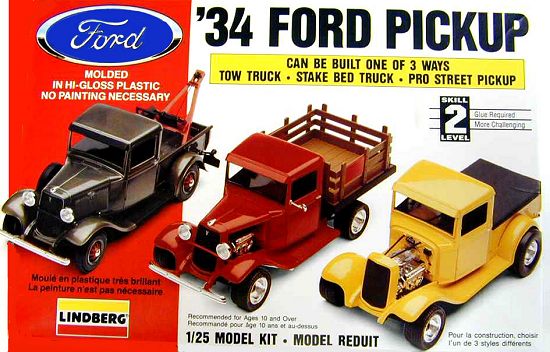
Lindberg 1934 Ford Pickup Truck 3 in 1
| KIT # |
72157 |
| PRICE: |
$10 |
| DECALS: |
Commercial stake and wrecker, Pro Street Rod |
| REVIEWER: | Blair Stewart |
| NOTES: |
Last appearance of a classic kit that’s been around since 1963; currently out of production |

|
HISTORY |
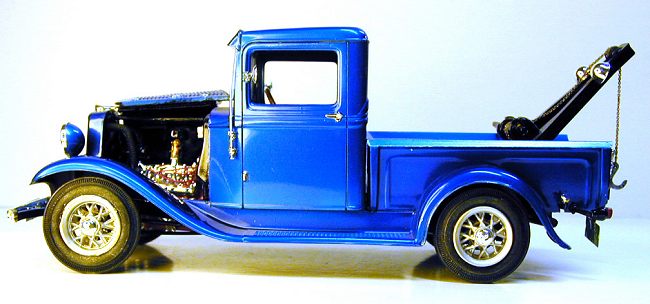
 The Ford Motor
Company introduced its first “pickup” truck in 1924 when Henry Ford bolted a
little box on his Model T roadster frame instead of the customary turtle deck.
These first Ford pickups (the honor of constructing the first pickup in the
world, or at least America, apparently went to A. W. King in 1896 when he
introduced the King High-Wheeler, which resembled a wagon with a flatbed rear
deck and seated two people) were called “pie wagons,” due to the crescent shape
of the body cutout that outlined the driver’s compartment. Throughout these
early years, pickups were very utilitarian: they were meant for working and
hauling. They shared the chassis, fenders and running gear of the Ford passenger
cars and were open-cab until 1928, when Ford introduced the first closed-cab
pickup. The overall design and construction of these pickups remained relatively
unchanged until Ford introduced its V-8 flathead motor in 1932. Both Ford cars
and trucks also received a styling upgrade, primarily a painted radiator shell.
The Ford Motor
Company introduced its first “pickup” truck in 1924 when Henry Ford bolted a
little box on his Model T roadster frame instead of the customary turtle deck.
These first Ford pickups (the honor of constructing the first pickup in the
world, or at least America, apparently went to A. W. King in 1896 when he
introduced the King High-Wheeler, which resembled a wagon with a flatbed rear
deck and seated two people) were called “pie wagons,” due to the crescent shape
of the body cutout that outlined the driver’s compartment. Throughout these
early years, pickups were very utilitarian: they were meant for working and
hauling. They shared the chassis, fenders and running gear of the Ford passenger
cars and were open-cab until 1928, when Ford introduced the first closed-cab
pickup. The overall design and construction of these pickups remained relatively
unchanged until Ford introduced its V-8 flathead motor in 1932. Both Ford cars
and trucks also received a styling upgrade, primarily a painted radiator shell.
The Ford pickup’s styling essentially remained the same from 1932 through the 1934 model year. Minor styling changes to the 1934 model included a new side hood insignia and a chrome front bumper. The primary change for the V-8 motor that year was the substitution of a Stromberg carburetor in place of a Detroit Lubricator carb.
Over the years, the 1934 Ford pickup has become a favorite of collectors, restorers, and hot rodders, and has always been a high demand subject for scale modelers.
|
THE KIT |
 AMT released the
first 1/25 scale 1934 Ford pickup kit in 1963. It was a major upgrade and step
forward from its other Trophy Series Fords, which included the 1932, 1936 and
1940 Fords (boy, do I have fond memories of building those kits when they first
came out – won my one and only model contest with a Candy Green [applied with a
spray can, no less, as airbrushes were unheard of at the time], customized 1936
Coupe, a gold painted Pontiac V-8 engine with 6 carbs, and patterned felt glued
to the seats to simulate upholstery!).
AMT released the
first 1/25 scale 1934 Ford pickup kit in 1963. It was a major upgrade and step
forward from its other Trophy Series Fords, which included the 1932, 1936 and
1940 Fords (boy, do I have fond memories of building those kits when they first
came out – won my one and only model contest with a Candy Green [applied with a
spray can, no less, as airbrushes were unheard of at the time], customized 1936
Coupe, a gold painted Pontiac V-8 engine with 6 carbs, and patterned felt glued
to the seats to simulate upholstery!).
First released as Kit No. T134, the initial issue was a 3 in 1 kit that featured stock, custom and service versions of the truck. The kit included a towing boom, tools, air horns, both stock flathead V-8 and a Thunderbird triple carb 390 cid V-8, stock and chromed tires and wheels, and vintage Ford dealership decals. Over the years, AMT reissued the kit with various changes such as their late 60’s version (No. T314), which added a stake truck version with duallie rear wheels.
AMT again reissued the kit in the late 70s, and then it quietly disappeared from the modeling radar screen. Auto modelers frequently requested another reissue, but, according to the October 1993 issue of Scale Auto Enthusiast (SAE) Magazine, AMT claimed “they couldn’t find the ‘tool’ used to produce the ’34, and therefore couldn’t reissue the kit.”
Then, in 1991 Lindberg announced that they were issuing a 1934 Ford pickup kit in 1/25 scale. The kit was an immediate sellout, and when “old timey” modelers who purchased the kit examined it, they found an amazing resemblance to the AMT tool. In fact, SAE pronounced in its article, “there’s not the slightest doubt that this kit is produced from AMT’s old ‘lost tool.’” The fact that this subject was long sought by modelers was born out when SAE readers voted the Lindberg 1934 Pickup Truck kit as the Best Reissue of 1991 (voting took place in 1992).
The first
Lindberg issue, No. 72154, was the standard AMT kit with three options: stock,
custom street, and racing. Two years later, Lindberg issued a reboxed kit, No.
72157 (the subject of this review), which included the stock, stake bed, and
wrecker versions. Also included in this version were the towing boom plus a
toolbox, tools, jack, and spare battery.
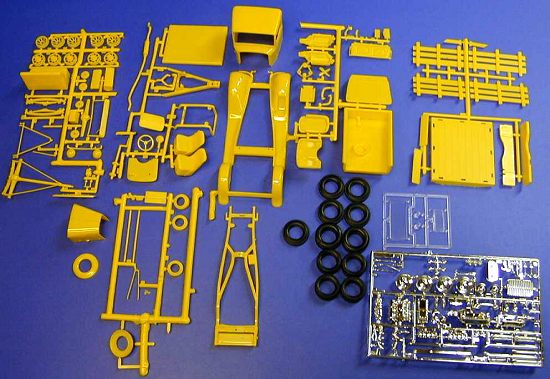
Although the kit is once again out of production, you can still find them at reasonable prices ($8-10) at on-line hobby shops that specialize in auto and truck models.
On opening the box, one is greeted by bright yellow plastic (Lindberg polished the body surfaces of the tool and molded the kit in plastic so that young modelers wouldn’t have to paint the kit once assembled; ergo, the claim on the box lid of “Molded in Hi-Gloss Plastic: No Painting Necessary”). The kit contains four trees of yellow parts, one tree of clear parts, one tree of chromed parts, and the separately molded cab, frame, and hood. There are a total of 11 rubber tires in the kit to support construction of the three different options. Additional “spare” parts include an engine stand, bucket and bench seats, chrome rims, a tool box, and a host of small tools for the bed. The decal sheet contains various emblems and body striping, depending on the model one chooses to construct.
|
CONSTRUCTION |
After about 5 microseconds of careful consideration, I decided to model the stock version of the tow truck. I first glued together the pickup bed frame, glued the visor to the outside of the cab, and sent both along with the fenders to the paint shop.
I next assembled the stock frame, including the axles and drive shaft, and sent this assembly to the paint shop. Other subassemblies such as the towing boom, wheels and flathead V-8 engine block were glued together and set aside for painting. In anticipation of finishing my model with an open-hood, I took an Exacto knife and cut off one side of the hood cowling so that it could later be painted and glued in the folded, open position to display the engine compartment.
|
PAINT & FINAL ASSY |
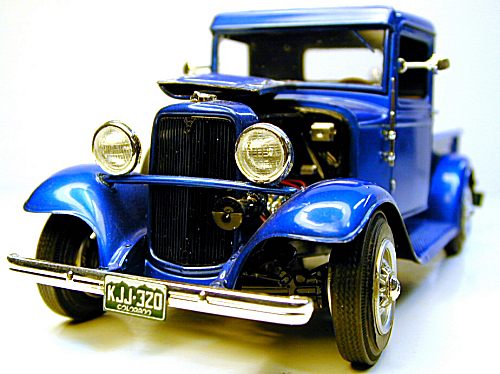 Moving to the
bed, I sprayed the bed boards with Model Masters (MM) Wood, and then dry-brushed
them with MM Rust to simulate the wood grain. I finished the bed by hand
painting the steel separator rails with Pactra Steel (yes, I still have bottles
of Pactra paint that are good!). I finished off the bed by gluing the floor into
the previously painted bed.
Moving to the
bed, I sprayed the bed boards with Model Masters (MM) Wood, and then dry-brushed
them with MM Rust to simulate the wood grain. I finished the bed by hand
painting the steel separator rails with Pactra Steel (yes, I still have bottles
of Pactra paint that are good!). I finished off the bed by gluing the floor into
the previously painted bed.
I sprayed the cab’s bench seat with MM Wood and glued it into the cab interior. In keeping with my slightly customized, slightly modern, stock truck theme, I hand-painted the steering wheel with MM Rust to give it a polished wood look. I picked out the instruments on the dash using Testors Chrome Silver.
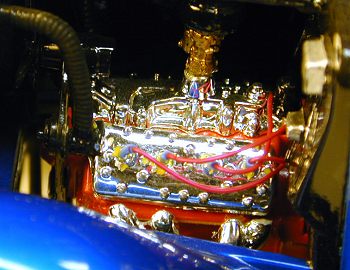 The engine was
the next subassembly that I tackled. I painted the flathead’s block with MM Ford
Engine Red, attached the chrome plated heads, intake and exhaust manifolds, and
the carburetor. I hand painted the carb with MM brass and attached the air
cleaner. I then painted the distributor cap, water pump, and generator Testors
Gloss Black.
The engine was
the next subassembly that I tackled. I painted the flathead’s block with MM Ford
Engine Red, attached the chrome plated heads, intake and exhaust manifolds, and
the carburetor. I hand painted the carb with MM brass and attached the air
cleaner. I then painted the distributor cap, water pump, and generator Testors
Gloss Black.
In breaking with my normal “out of the box” approach to modeling, I decided to wire the engine, so I used a pin vise to drill small holes in the distributor cap. I then attached scale red wires from the distributor to the cylinders using Super Glue. The completed engine was dropped into the stock frame and glued to it. I next glued the radiator hoses, painted Testors Flat Black, to the engine and the radiator.
I painted the stock wire wheels with MM Non-Buffing Aluminum Metalizer, then glued on the stock tires and the chrome hubcaps. These were then attached to the axles over the gloss black brake drums. I attached the firewall to the cab, hand-painted some of the electrical boxes on the firewall with Testors Aluminum, and then attached the cab to the frame. The assembled bed was attached to the frame at this point. The hood was then installed, and the left side was glued in the open, accordion position to display the engine.
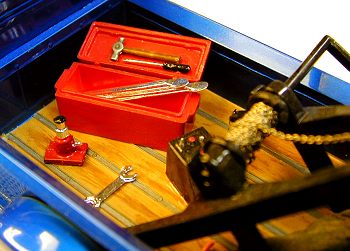 I
completed the truck assembly by attaching the front chrome bumper, the door
handles, radio antenna, side mirrors, gas cap, and headlights. The clear
headlight lenses and the red taillight lens were attached using white glue. I
then brush painted the tailgate chains with MM Aluminum and Flat Black.
I
completed the truck assembly by attaching the front chrome bumper, the door
handles, radio antenna, side mirrors, gas cap, and headlights. The clear
headlight lenses and the red taillight lens were attached using white glue. I
then brush painted the tailgate chains with MM Aluminum and Flat Black.
 pickup
bed. I added a small length of orange-insulated hookup wire to replicate a
towing strap, and a rolled up Olive Drab tarp made from Kleenex, which I had
soaked in diluted white glue. The final touch was a Colorado license plate that
I made using Adobe Illustrator and printed on an inkjet printer.
pickup
bed. I added a small length of orange-insulated hookup wire to replicate a
towing strap, and a rolled up Olive Drab tarp made from Kleenex, which I had
soaked in diluted white glue. The final touch was a Colorado license plate that
I made using Adobe Illustrator and printed on an inkjet printer.
|
CONCLUSIONS |
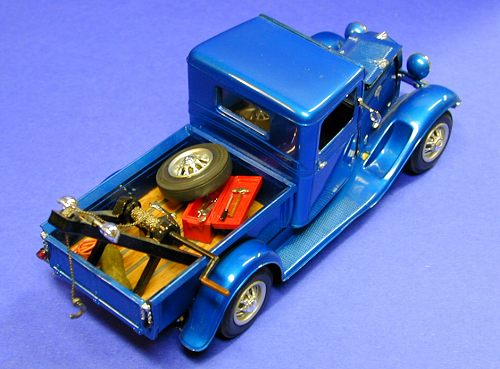 This is the only
game in town as far as plastic, 1/25th 1934 Ford pickups is
concerned. Although the kit is now almost 40 years old, it still builds into a
good representation of the venerable prototype. There are some very minor fit
problems associated with the bed frame and the usual minor problems associated
with mating the body, fenders and bed to the frame, but all in all, this is
still an excellent kit. The optional goodies included in the box are an added
bonus for auto modelers. I enjoyed constructing this kit and recommend it to
all, especially as a break for all of you “aircraft-only” types (Sorry: couldn’t
resist that, but I promise to “re-cross” from the Dark Side of Modeling as soon
as possible; meanwhile, I am actively seeking therapy for my acute condition!).
This is the only
game in town as far as plastic, 1/25th 1934 Ford pickups is
concerned. Although the kit is now almost 40 years old, it still builds into a
good representation of the venerable prototype. There are some very minor fit
problems associated with the bed frame and the usual minor problems associated
with mating the body, fenders and bed to the frame, but all in all, this is
still an excellent kit. The optional goodies included in the box are an added
bonus for auto modelers. I enjoyed constructing this kit and recommend it to
all, especially as a break for all of you “aircraft-only” types (Sorry: couldn’t
resist that, but I promise to “re-cross” from the Dark Side of Modeling as soon
as possible; meanwhile, I am actively seeking therapy for my acute condition!).
|
REFERENCES |
Copyright ModelingMadness.Com If you would like your product reviewed fairly and fairly quickly, please contact the editor or see other details in the Note to
Contributors.
Back to Reviews Page 2019